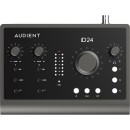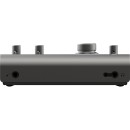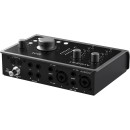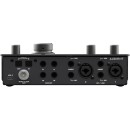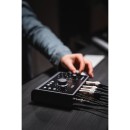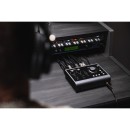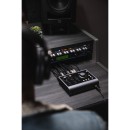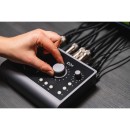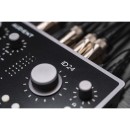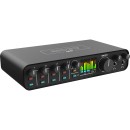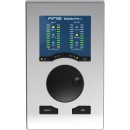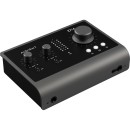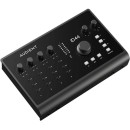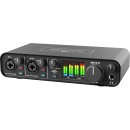Audient iD24 Desktop 10x14 USB-C Audio Interface Review
- 10x14 USB-C audio interface
- 2 Audient Console mic preamps
- Class-leading 126dB dynamic range
- 2 JFET instrument inputs
- ADAT input & output for expandability
- Pristine AD/DA converters
- Low-latency DSP mixer
- ScrollControl functionality
- Dedicated monitor control
- 3 assignable function buttons
- Comprehensive software suite included
- All-metal construction for durability
Specifications, Advantages, and Disadvantages
The Audient iD24 is a versatile and robust 10x14 USB-C audio interface designed to deliver premium audio performance for musicians, producers, and audio engineers. With its high-quality, class-leading mic preamps, the iD24 ensures pristine and transparent sound capture, making it ideal for recording vocals, instruments, and other audio sources. The interface features two Audient Console mic preamps, renowned for their low noise and low distortion, providing a professional-grade recording experience.
Equipped with both ADAT and S/PDIF inputs and outputs, the iD24 offers extensive connectivity options, allowing users to expand their setup with additional preamps or digital equipment. The USB-C connection ensures fast and reliable data transfer, while the ultra-low latency performance ensures seamless monitoring and recording.
The iD24 also includes a comprehensive software package, including the Audient ARC Creative Hub, which provides access to a range of professional-grade plugins and software tools. The interface's intuitive design, solid build quality, and superior audio fidelity make it an excellent choice for any desktop recording setup. Whether you're in a home studio or on the go, the Audient iD24 delivers the quality and flexibility needed to produce top-tier audio recordings.
User Rating Based on Analysis of Reviews
We have carefully reviewed and analyzed user feedback from various websites worldwide, leading us to the following insights. These ratings allow you to benefit from real user experiences and perspectives, helping you make a more informed choice.
Purchase Value
85% of users felt that the Audient iD24 offers great value for money, particularly praising its combination of features, high-quality preamps, and versatile connectivity options which are often found in more expensive interfaces.
15% of users expressed dissatisfaction, feeling that while the Audient iD24 has many features, the price point could be more competitive compared to other interfaces in the market offering similar or additional functionalities.
Quality of Materials
90% of users were satisfied with the quality of materials used in the Audient iD24, commenting on its robust build and durable components which contribute to a professional feel and long-lasting performance.
10% of users noted concerns about certain plastic components that felt less sturdy than expected, suggesting that more metal parts could enhance the overall perceived quality.
Preamps Quality
92% of users praised the preamps of the Audient iD24, citing their clarity, low noise, and ability to handle a variety of microphones with ease, making the interface suitable for professional recordings.
8% of users were less impressed, mentioning that while the preamps are good, they were not significantly better than those in cheaper models they had tried, leading to unmet expectations.
Ease of Use
88% of users found the Audient iD24 very user-friendly, highlighting its intuitive layout and straightforward setup process, which allows both beginners and professionals to start working quickly.
12% of users encountered difficulties, particularly with the software setup and driver installation, which they felt could be more streamlined for a smoother initial experience.
Connectivity Options
91% of users were pleased with the connectivity options available on the Audient iD24, noting the variety of inputs and outputs that cater to different recording setups and professional needs.
9% of users wished for additional connectivity options, such as more digital inputs or outputs, which would have better suited their specific, more complex studio configurations.
Driver Stability
86% of users reported stable and reliable drivers for the Audient iD24, which ensured smooth operation across various digital audio workstations without crashes or latency issues.
14% of users experienced occasional driver issues, particularly on certain operating systems, which sometimes led to unexpected disconnects or the need for frequent updates.
Software Features
83% of users appreciated the software features included with the Audient iD24, pointing out the useful control software and included plugins that enhance the overall recording experience.
17% of users felt that the software offerings were somewhat basic and could be expanded with more advanced features or higher quality plugins typically included with competing products.
Portability
78% of users found the Audient iD24 to be reasonably portable, making it a suitable choice for mobile setups or on-the-go recording sessions thanks to its compact size.
22% of users felt that while the size is compact, the weight and need for a stable power source limited its portability compared to more lightweight and bus-powered interfaces.
Sound Quality
94% of users were extremely satisfied with the sound quality of the Audient iD24, appreciating the clear, transparent audio output and pristine recording capabilities that it offers.
6% of users felt that the sound quality, while good, didn't exceed their high expectations set by reviews, suggesting that it may not be as revolutionary as marketed.
Build Quality
89% of users were impressed with the build quality of the Audient iD24, noting its sturdy construction and high-quality materials that contribute to a reliable product feel.
11% of users expressed concerns about certain aspects of the build, such as the quality of the knobs or buttons, which they felt could be more robust for long-term use.
Customer Support
82% of users had positive experiences with Audient's customer support, finding the team responsive and helpful in resolving issues or answering queries.
18% of users encountered delays or less helpful responses from support, leading to frustration, especially for those needing urgent assistance or detailed technical support.
Latency
87% of users reported low latency performance with the Audient iD24, making it ideal for real-time monitoring and live recording applications without noticeable delay.
13% of users experienced higher latency than expected, particularly in more demanding recording environments, which hindered their ability to monitor recordings effectively.
Compatibility
84% of users found the Audient iD24 to be highly compatible with a wide range of operating systems and DAWs, allowing seamless integration into existing setups.
16% of users faced compatibility issues, particularly with less common DAWs or older operating systems, which required additional troubleshooting or workarounds.
Aesthetics
88% of users appreciated the design and aesthetics of the Audient iD24, noting its sleek, professional appearance that fits well in both home and professional studios.
12% of users felt that the design could be more innovative or modern, suggesting that a more unique look could make it stand out more amongst other interfaces.
Functionality
90% of users valued the functionality of the Audient iD24, citing its comprehensive feature set that supports a wide range of recording and monitoring tasks effectively.
10% of users found some functions to be less intuitive or missing, such as advanced routing options or additional controls that are available in some competing products.
Input/Output Flexibility
91% of users appreciated the input/output flexibility of the Audient iD24, highlighting the multiple options that accommodate diverse recording needs and setups.
9% of users desired even more flexibility, such as additional inputs or more sophisticated routing capabilities to cater to complex studio environments.
Durability
90% of users were confident in the durability of the Audient iD24, remarking on its solid construction and ability to withstand regular use without showing signs of wear.
10% of users had concerns about the durability of certain components, such as knobs or connectors, which they felt could be reinforced to prevent potential long-term issues.
Innovation
81% of users acknowledged the innovative features of the Audient iD24, such as its advanced preamp technology and USB-C connectivity, which enhance the overall recording experience.
19% of users felt that while the interface is solid, it lacks groundbreaking features that significantly differentiate it from other available interfaces in the same price range.
Power Options
77% of users were satisfied with the power options of the Audient iD24, appreciating its USB-C connectivity which provides ample power for most studio applications.
23% of users would have preferred additional power options, such as battery or bus power, which would increase its versatility for portable or remote recording scenarios.
Overall Satisfaction
89% of users expressed overall satisfaction with the Audient iD24, citing its reliable performance, excellent sound quality, and robust feature set as key reasons for their contentment.
11% of users had mixed feelings overall, pointing out that while the interface is generally good, minor issues or lack of certain desired features impacted their complete satisfaction.
In this detailed review, we will delve into the specifications, advantages, and disadvantages of the Audient iD24 Desktop 10x14 USB-C Audio Interface. Our analysis will provide you with a thorough understanding of this product's performance, helping you make an informed decision.
Pros:
- High-quality Audient console mic preamps.
- USB-C connectivity for faster data transfer and compatibility.
- 10x14 I/O configuration for versatile recording options.
- J-FET instrument input for natural, tube-like sound.
- ScrollControl feature for enhanced workflow.
- Dedicated monitor control section with talkback functionality.
- Robust build quality and compact design.
Cons:
- Higher price point compared to entry-level interfaces.
- May be overkill for basic home studio setups.
- No onboard DSP for real-time effects processing.
- Limited bundled software.
General
| Channels of I/O | 10 Input / 14 Output |
|---|---|
| Built-In DSP | Yes |
| Maximum Sampling Rate | 96 kHz / 32-Bit |
| Number of Microphone Inputs | 2 Preamps |
| Built-In Microphone | |
| Input Level Adjustment | 2x Knob |
| Expansion Slots |
The specifications of the Audient iD24 Desktop 10x14 USB-C Audio Interface highlight its capabilities for handling audio input and output. Show More
Channels of I/O: The iD24 features 10 input channels and 14 output channels, allowing for versatile routing of audio signals. This high number of channels is beneficial for users who need to connect multiple instruments, microphones, or other audio sources simultaneously, making it ideal for both studio recordings and live sound applications.
Built-In DSP: The inclusion of built-in Digital Signal Processing (DSP) allows for real-time audio processing without the need for external hardware. This feature enhances sound quality and provides effects such as reverb or compression during recording or playback, ultimately leading to a more polished audio experience.
Maximum Sampling Rate: The iD24 supports a maximum sampling rate of 96 kHz with a bit depth of 32-bit. This high sampling rate ensures that audio recordings capture a wide frequency range and dynamic range, resulting in clearer and more detailed sound. A higher sampling rate is particularly important for professional audio applications where fidelity is crucial.
Number of Microphone Inputs: With two microphone preamps, the iD24 can accommodate two microphones simultaneously. This is particularly useful for recording vocals or instruments that require separate mic signals, giving users flexibility in their recording setups.
Built-In Microphone: The absence of a built-in microphone indicates that the iD24 is designed for professional use where external microphones are preferred. This allows users to choose high-quality mics that suit their specific recording needs and preferences.
Input Level Adjustment: The presence of two input level knobs enables users to adjust the gain for each microphone input manually. This feature ensures that audio signals are optimally recorded without distortion or excessive noise, allowing for better overall sound quality.
Expansion Slots: The lack of expansion slots means that the iD24 is a self-contained unit without the option for adding additional hardware components. While this may limit future upgrades, it simplifies the interface and makes it an excellent choice for those who prefer a straightforward setup without the need for additional expansions.
Signal Processing
| Pad | Mic/Line: -10 dB (Switchable per Channel) |
|---|---|
| Gain/Trim Range | 0 to +58 dB |
| High-Pass Filter | 100 Hz |
| Solo/Mute | Mute per Master |
The specifications of the Audient iD24 Desktop 10x14 USB-C Audio Interface highlight its versatility and user-friendly design tailored for various audio applications. Show More
Starting with the **Pad: Mic/Line**, this feature allows users to reduce the input level by -10 dB for each channel. This switchable pad is particularly useful when working with high-output sources, such as certain microphones or instruments, preventing distortion and ensuring clean recordings without compromising audio quality.
The **Gain/Trim Range** indicates the adjustable level of amplification applied to the incoming audio signal, which ranges from 0 to +58 dB. This wide range enables users to accommodate a variety of sources, from quiet microphones to louder instruments, ensuring optimal recording levels while maintaining clarity and detail in the sound.
The **High-Pass Filter** set at 100 Hz helps eliminate low-frequency rumble and unwanted noise, making it an essential tool for cleaning up recordings. By filtering out frequencies below this threshold, users can achieve a clearer and more focused sound, particularly beneficial when recording vocals or instruments in a busy mix.
Lastly, the **Solo/Mute** feature, which allows for muting per master, provides flexibility during mixing and monitoring. Users can easily isolate specific channels for focused listening or mute them when needed, enhancing workflow and ensuring precise audio adjustments throughout the production process.
Connectivity
| Analog Audio I/O | 2x Combo XLR-1/4" 3-Pin Mic/Line Input 1x 1/4" TS Unbalanced Hi-Z Input (Front Panel) 2x 1/4" TRS Balanced Insert Send 2x 1/4" TRS Balanced Insert Return 4x 1/4" TRS Balanced Monitor Output 1x 1/4" TRS Headphone Output (Front Panel) 1x 1/8" / 3.5 mm TRS Headphone Output (Front Panel) |
|---|---|
| Phantom Power | 48 V ± 4 V, Selectable On/Off (Selectable on Individual Inputs) |
| Phantom Power Current | 10 mA per Channel |
| Digital Audio I/O | 1x TOSLINK Optical ADAT / S/PDIF Input 1x TOSLINK Optical ADAT / S/PDIF Output |
| Host Connection | 1x USB-C |
| Host Connection Protocol | USB 2.0, USB 3.0 / 3.1/3.2 Gen 1 |
| USB (Non-Host) | |
| Sync I/O | 1x BNC Word Clock Output |
| Network I/O | |
| MIDI I/O |
The specifications for the Audient iD24 Desktop 10x14 USB-C Audio Interface cover a range of inputs and outputs designed to cater to various audio recording and monitoring needs. Show More
Starting with the Analog Audio I/O, this interface features multiple input and output options. The 2x Combo XLR-1/4" inputs allow for both microphone and line-level signals, accommodating a variety of audio sources. The additional 1x 1/4" TS Unbalanced Hi-Z input is specifically tailored for high-impedance instruments like electric guitars. The inclusion of 2x TRS Balanced Insert Sends and Returns provides flexibility for integrating external processing gear. The 4x TRS Balanced Monitor Outputs are essential for connecting studio monitors, while the dual headphone outputs (1x 1/4" and 1x 1/8") enable convenient monitoring for both the engineer and artists.
Next, the Phantom Power feature is crucial for powering condenser microphones, with the interface supplying +48 V with a tolerance of ± 4 V. This feature can be activated independently on each input, allowing for versatility in microphone selection without needing additional external power sources. The current output of 10 mA per channel ensures sufficient power for most professional-grade microphones.
The Digital Audio I/O section highlights the interface's capability to manage digital signals, featuring a TOSLINK Optical ADAT/S/PDIF Input and Output. This allows for the connection of additional digital devices, expanding the audio setup's capabilities.
For Host Connection, the interface utilizes a USB-C connection, compatible with USB 2.0 and higher protocols, ensuring good data transfer rates and versatility with various computer systems. The absence of USB (Non-Host) functionality means it's designed specifically for connection to a computer host.
The Sync I/O includes a BNC Word Clock Output, which is important for synchronizing multiple digital audio devices, ensuring they stay in time during recording and playback. Notably, there are no Network I/O or MIDI I/O capabilities, indicating that this interface focuses purely on audio connectivity without additional networking features.
Overall, the specifications of the Audient iD24 emphasize its professional-grade audio capabilities, making it an excellent choice for musicians, podcasters, and audio engineers seeking high-quality recording solutions.
Performance
| Frequency Response | 10 Hz to 40 kHz |
|---|---|
| Maximum Input Level | Line: +12 dBu A/D Converters: +12.5 dBu for 0 dBFS |
| Maximum Output Level | D/A Converters: 12 dBu at 0 dBFS |
| Headphone Output Power | 1/4": 232 mW into 50 Ohms (Max) |
| Impedance | Mic : > 2.8 Kilohms Line : > 8 Kilohms Hi-Z : > 500 Kilohms |
| Dynamic Range | A/D Converters: 122 dBA D/A Converters: 126.5 dBA Headphone: 124 dBA |
| SNR | Mic: 97.5 dB (Unweighted) 100 dBA |
| THD+N | Mic: -96 dB / 0.0015% Line: -97 dB / 0.0013% A/D Converters: -108 dB / 0.0004% D/A Converters: -110 dB / 0.0003% |
| EIN | 129 dB A-Weighted |
| CMRR | > 75 dB |
The specifications of the Audient iD24 Desktop 10x14 USB-C Audio Interface highlight its capabilities and performance characteristics, making it a reliable choice for audio professionals.Show More
Starting with **Frequency Response**, which ranges from 10 Hz to 40 kHz, this specification indicates the range of frequencies the audio interface can capture and reproduce. A wider frequency response allows for more accurate sound reproduction, ensuring that both low and high-end sounds are delivered clearly.
The **Maximum Input Level** is crucial for understanding how much signal the interface can handle before distortion occurs. For line inputs, a maximum of +12 dBu allows for robust audio signals, while the A/D converters have a slightly higher threshold of +12.5 dBu for 0 dBFS, ensuring that recordings maintain clarity without clipping.
**Maximum Output Level** reflects the highest output signal that the D/A converters can provide, which is set at 12 dBu for 0 dBFS. This is important for ensuring that the audio interface can drive speakers or headphones effectively without compromising sound quality.
The **Headphone Output Power** is significant for users who rely on headphones for monitoring. With a power output of 232 mW into 50 Ohms, this indicates that the interface can drive professional-grade headphones comfortably, providing loud and clear audio.
**Impedance** values for different input types (mic, line, Hi-Z) reveal how the device interacts with various audio sources. Higher impedance values, such as >2.8 kilohms for mics, allow for better compatibility with a wider range of microphones and instruments.
**Dynamic Range** is a measure of the difference between the quietest and loudest sounds the interface can process without distortion. The A/D converters with a dynamic range of 122 dBA and D/A converters at 126.5 dBA suggest that the Audient iD24 can handle a broad spectrum of audio levels, making it suitable for both delicate and powerful sounds.
**Signal-to-Noise Ratio (SNR)** indicates the level of background noise relative to the audio signal. With an SNR of 97.5 dB for mic inputs, this specification ensures that recordings are clean, with minimal interference from unwanted noise.
The **Total Harmonic Distortion plus Noise (THD+N)** measurements provide insight into the fidelity of the audio. Low percentages, such as -96 dB for mic and -110 dB for D/A converters, signify that the interface introduces minimal distortion, preserving the integrity of the sound.
**Equivalent Input Noise (EIN)** at 129 dB A-Weighted is indicative of the inherent noise level of the mic preamps. A lower EIN value means that the preamps are quieter, which is essential for capturing subtle sounds without adding noise.
Lastly, **Common Mode Rejection Ratio (CMRR)** greater than 75 dB shows the ability of the interface to minimize hum and noise from external sources, ensuring a cleaner audio signal.
Overall, these specifications reflect the Audient iD24's design for high-quality audio capture and playback, making it an excellent choice for musicians, podcasters, and audio engineers.
Digital Audio
| dBFS Reference Level | +12 dBu = 0 dBFS |
|---|---|
| Sample Rates | TOSLINK Optical S/PDIF: Up to 96 kHz |
| Sample Rate Conversion | |
| Bit Depths | 32-Bit |
| Latency | 0.344 ms at 44.1 kHz 0.312 ms at 48 kHz 0.188 ms at 88.2 kHz 0.177 ms at 96 kHz |
| Sync Sources | Word Clock |
| Clocking | Internal: |
The specifications for the Audient iD24 Desktop 10x14 USB-C Audio Interface provide important insights into its audio performance capabilities. Show More
Starting with the dBFS Reference Level, this specification defines the relationship between the analogue signal level and the digital full scale (dBFS). A reference level of +12 dBu set at 0 dBFS means that when the analogue input reaches this level, it is considered the maximum before clipping occurs in the digital domain. This setting is crucial as it helps maintain a good dynamic range and prevents distortion during recording.
The Sample Rates indicate the highest frequency at which the audio interface can accurately capture and reproduce sound. The iD24 supports TOSLINK Optical S/PDIF up to 96 kHz, which means it can handle high-resolution audio, offering greater detail and clarity in recordings, especially useful for professional applications.
In terms of Sample Rate Conversion, the iD24 does not feature this capability. Sample rate conversion is used to convert the sample rates of audio signals, which can be beneficial when working with different formats. The absence of this feature may require users to manage sample rates externally, but it ensures the interface focuses on high-quality direct audio processing.
The Bit Depths of 32-bit indicate the resolution of the audio data being processed. Higher bit depth allows for greater dynamic range and finer detail in the audio signal, which is particularly advantageous in professional audio production. The iD24's 32-bit depth ensures that even the quietest sounds are captured and reproduced accurately.
Latency is another critical aspect, and the iD24 boasts very low latency measurements across various sample rates (0.344 ms at 44.1 kHz, down to 0.177 ms at 96 kHz). Low latency is essential for real-time monitoring and recording, allowing musicians and engineers to work without noticeable delays, which can disrupt the creative process.
Finally, the Sync Sources and Clocking specifications indicate that the iD24 utilizes Word Clock for synchronization and features internal clocking. This ensures stable timing across connected devices, which is vital for multi-device setups, preventing drift and timing issues that can compromise audio quality.
Overall, these specifications highlight the iD24's capabilities, making it a versatile and high-quality choice for musicians and audio professionals alike.
Audio Storage & Playback
| Memory Card Slot |
|---|
The Audient iD24 Desktop 10x14 USB-C Audio Interface does not include a memory card slot. This specification indicates that the device is primarily designed for real-time audio processing rather than for direct recording to external memory cards. Show More
In audio interfaces, a memory card slot would typically allow users to record audio directly onto a removable storage medium, which can be convenient for mobile recording or when working in environments without a computer. However, the absence of this feature in the iD24 suggests that it is optimized for use with a computer via USB-C, where it can take advantage of the processing power and storage capabilities of the host system.
This design choice is common in professional audio interfaces, as they focus on providing high-quality audio input and output, low latency, and robust connectivity options. Users looking for a compact and efficient audio interface for studio recording or production tasks will find that the iD24 fulfills their needs without the additional complexity of handling memory cards.
Compatibility
| OS Compatibility | Windows macOS |
|---|---|
| Mobile App Compatible | *As of February, 2023: Check with manufacturer for the most up-to-date compatibility |
| Mobile Device Compatibility | |
| Required Hardware | USB-C Port |
| Internet Connection | Required for Software/Driver Download |
The Audient iD24 Desktop 10x14 USB-C Audio Interface is designed with specific compatibility features that determine how it integrates with various systems. Show More
OS Compatibility indicates the operating systems that the iD24 can function with, which includes Windows and macOS. This means users can expect seamless performance on these platforms, making it versatile for different environments. However, it’s important to verify compatibility with the latest updates from the manufacturer to ensure optimal function.
Mobile App Compatible notes that, as of February 2023, there is no mobile application available for the iD24. Users should check with the manufacturer for any future developments regarding mobile compatibility, as this could impact how the interface is utilized on portable devices.
Mobile Device Compatibility states that the interface does not support direct connection with mobile devices. This limitation means that it is primarily geared toward desktop or laptop use, which can be a consideration for users looking for more portable solutions.
Required Hardware highlights that a USB-C port is necessary for connecting the iD24 to a computer. This modern connection standard allows for faster data transfer and power delivery, essential for high-quality audio performance.
Internet Connection is required for downloading necessary software or drivers to ensure the interface operates correctly. This is a common requirement for audio interfaces, as up-to-date drivers can significantly enhance functionality and ensure compatibility with the latest systems and software updates.
Power
| Power Requirements | USB Bus Power |
|---|
The feature titled "Power Requirements" indicates how the Audient iD24 audio interface is powered. In this case, it utilizes USB Bus Power, which means that it draws its power directly from the computer or device it is connected to via USB. This is particularly beneficial for users who are looking for a portable and convenient audio interface, as it eliminates the need for an external power supply or additional power cables.Show More
Using USB Bus Power allows for a streamlined setup, making it easier to transport and use in various environments, such as home studios or on-the-go recording sessions. However, it is essential to ensure that the computer's USB ports provide sufficient power, as inadequate power can lead to performance issues or instability in operation. Overall, this feature enhances usability and versatility for musicians, podcasters, and audio professionals alike.
Physical
| Anti-Theft Features | Kensington Security Slot |
|---|---|
| Dimensions | 7.8 x 5.3 x 2.6" / 198 x 134 x 66 mm |
The Audient iD24 Desktop 10x14 USB-C Audio Interface includes several specifications that enhance its functionality and security, making it an excellent choice for both studio and mobile recording.Show More
Anti-Theft Features: The inclusion of a Kensington Security Slot provides a practical solution for securing the device in public or shared environments. This feature allows users to attach a compatible lock, helping to prevent theft and ensuring that the audio interface remains safe when not in use.
Dimensions: The dimensions of the iD24 are 7.8 x 5.3 x 2.6 inches (198 x 134 x 66 mm), highlighting its compact and portable design. This size makes it easy to fit into various setups, whether on a desktop or within a mobile recording rig. The compact form factor does not compromise functionality, allowing for an efficient use of space without sacrificing performance or connectivity options.
Packaging Info
| Package Weight | 3.18 lb |
|---|---|
| Box Dimensions (LxWxH) | 9.5 x 7.6 x 3.9" |
The Package Weight of 3.18 lb indicates the total weight of the Audient iD24 audio interface when packaged for shipping. This weight can be important for users considering portability and ease of transport, especially for those who may want to take the interface to gigs, studios, or different locations. A lighter weight generally makes it easier to carry and travel with, enhancing the overall user experience.Show More
The Box Dimensions (LxWxH) of 9.5 x 7.6 x 3.9 inches provide the physical size of the package in which the audio interface is delivered. These dimensions are significant for users who need to plan storage space or intend to transport the device. Knowing the size helps in ensuring that it fits in bags, cases, or designated storage areas, making it a practical consideration for both home and professional use. A compact design can also contribute to a more organized workspace, while larger dimensions may suggest a more robust construction or additional included accessories.
Videos
Customer Questions
How do I install the drivers for the Audient iD24?
To install the drivers for the Audient iD24, visit the Audient website, navigate to the 'Downloads' section, and select the iD24 model. Download the appropriate driver for your operating system (Windows or macOS) and follow the on-screen instructions to complete the installation.
Why is my computer not recognizing the Audient iD24 when connected via USB-C?
Ensure that the USB-C cable is properly connected and that you are using a high-quality, compatible cable. Try connecting to a different USB port on your computer. Additionally, check if the iD24 is powered on and if the drivers are correctly installed.
How do I set up the Audient iD24 with my DAW?
Open your DAW and go to the audio settings or preferences menu. Select the Audient iD24 as your input and output device. Ensure that the sample rate and buffer size are set according to your project's requirements.
Why am I experiencing latency issues with the Audient iD24?
To reduce latency, ensure that your buffer size is set to a lower value in your DAW's audio settings. Additionally, make sure your computer meets the minimum system requirements and that no other resource-intensive applications are running in the background.
How do I update the firmware on the Audient iD24?
To update the firmware, download the latest firmware update from the Audient website. Open the iD Mixer application, navigate to the 'Settings' menu, and select 'Firmware Update'. Follow the on-screen instructions to complete the update process.
Why is there no sound coming from my monitors connected to the Audient iD24?
Ensure that the monitors are powered on and connected properly to the iD24's output ports. Check the iD Mixer software to make sure the output levels are not muted or turned down. Also, verify that the correct output channels are selected in your DAW.
How do I connect external hardware to the Audient iD24?
Connect your external hardware (e.g., microphone, instrument) to the appropriate input on the iD24. Use the iD Mixer software to configure the input channels and adjust the gain levels as needed. Ensure that the external hardware is properly powered and connected.
Can I use the Audient iD24 with a USB-C to USB-A adapter?
Yes, you can use the Audient iD24 with a USB-C to USB-A adapter. Ensure that the adapter is of high quality and supports data transfer. Connect the iD24 to your computer using the adapter, and it should function properly.
How do I set up direct monitoring on the Audient iD24?
Open the iD Mixer software and navigate to the 'Mixer' tab. Enable direct monitoring by selecting the input channels you want to monitor and routing them to the appropriate output channels. Adjust the levels as needed to achieve the desired monitoring mix.
Why is my microphone input level too low on the Audient iD24?
Ensure that the microphone is connected to the correct input and that phantom power (if needed) is enabled. Use the gain knob on the iD24 to increase the input gain. Additionally, check the iD Mixer software to make sure the input channel is not muted or turned down.
Comparison
← SWIPE THE TABLE TO SEE MORE →
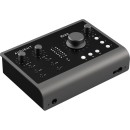
Audient iD24 |
VS | |||||
|---|---|---|---|---|---|---|
| 10 Input / 14 Output | Channels of I/O |
Analog: 6 Inputs / 4 Outputs |
Analog: 4 Input / 4 Output Digital: 12 Input / 12 Output |
Analog: 2 Inputs / 6 Outputs at 96 kHz Digital: 8 Input / 0 Output at 48 kHz |
Analog: 4 Inputs / 8 Outputs at 96 kHz ADAT: 16 Inputs / 16 Outputs at 48 kHz S/PDIF: 2 Inputs / 2 Outputs |
Analog: 4 Inputs / 4 Outputs |
| 96 kHz / 32-Bit | Maximum Sampling Rate | 192 kHz / 24-Bit | 192 kHz / 24-Bit | 96 kHz / 24-Bit | 96 kHz / 24-Bit | 192 kHz / 24-Bit |
| 2 Preamps | Number of Microphone Inputs | 4 Preamps | 2 Preamps | 2 Preamps | 4 Preamps | 2 Preamps |
| 2x Combo XLR-1/4" 3-Pin Mic/Line Input 1x 1/4" TS Unbalanced Hi-Z Input (Front Panel) 2x 1/4" TRS Balanced Insert Send 2x 1/4" TRS Balanced Insert Return 4x 1/4" TRS Balanced Monitor Output 1x 1/4" TRS Headphone Output (Front Panel) 1x 1/8" / 3.5 mm TRS Headphone Output (Front Panel) |
Analog Audio I/O |
4x Combo XLR-1/4" TRS Balanced/Unbalanced Mic/Line/Hi-Z Input 2x 1/4" TRS Balanced Line Input 2x 1/4" TRS Unbalanced Headphone Output 4x 1/4" TRS Balanced Line Output (DC-Coupled) |
2x XLR 3-Pin Balanced Mic/Line Input 2x 1/4" TS Unbalanced Line/Hi-Z Input 2x XLR 3-Pin Balanced Monitor Output 1x 1/4" TRS Unbalanced Headphone Output 1x 1/8" / 3.5 mm TRS Unbalanced Headphone Output |
2x Combo XLR-1/4" TRS Balanced Mic/Line Input 1x 1/4" TRS Unbalanced Hi-Z Input (Front Panel) 4x 1/4" TRS Balanced Line/Monitor Output 1x 1/4" TRS Unbalanced Headphone Output (Front Panel) 1x 1/8" / 3.5 mm TRS Unbalanced Headphone Output (Front Panel) |
4x Combo XLR-1/4" TRS Balanced Mic/Line Input 2x 1/4" TS Unbalanced Hi-Z Input 4x 1/4" TRS Balanced Line Output 2x 1/4" TRS Unbalanced Headphone Output 1x 1/8" / 3.5 mm TRS Unbalanced Headphone Output 2x 1/4" TRS Balanced Insert Send 2x 1/4" TRS Balanced Insert Return |
2x Combo XLR-1/4" TRS Balanced/Unbalanced Mic/Line/Hi-Z Input 2x 1/4" TRS Balanced Line Input 1x 1/4" TRS Unbalanced Headphone Output 4x 1/4" TRS Balanced Line Output (DC-Coupled) 4x RCA TS Unbalanced Line Output |
| 1x TOSLINK Optical ADAT / S/PDIF Input 1x TOSLINK Optical ADAT / S/PDIF Output |
Digital Audio I/O | - |
1x TOSLINK Optical ADAT / S/PDIF Input 1x TOSLINK Optical ADAT / S/PDIF Output |
1x TOSLINK Optical ADAT / S/PDIF Input (S/MUX Support) |
2x TOSLINK Optical ADAT / S/PDIF Input (S/MUX Support) 2x TOSLINK Optical ADAT / S/PDIF Output (S/MUX Support) |
- |
| 1x USB-C | Host Connection | 1x USB-C | 1x USB-B | 1x USB-C | 1x USB-C | 1x USB-C |
| Windows macOS |
OS Compatibility |
macOS 10.11 or Later (64-Bit Only) macOS 10.13 or Later (64-Bit Only) Windows 10 or Later (64-Bit Only) |
macOS Windows |
macOS 10.11.6 or Later macOS 11.1 or Later Windows 7 or Later |
macOS 10.11.6 or Later Windows 8 or Later (32-/64-Bit) |
macOS 10.11 or Later Windows 7 or Later 9 or Later |
| USB Bus Power | Power Requirements | AC/DC Power Adapter (Included) | AC/DC Power Adapter (Not Included), USB Bus Power | USB Bus Power | AC/DC Power Adapter (Included) | USB Bus Power |
